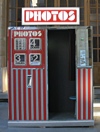
Photomaton & identity
History and split personality of the photobooth
History and split personality of the photobooth

This appliance can be seen from two aspects. On the one hand, it can deliver ludic portraits, solo or in group, showing our face just as we want it to be seen and displaying our attachment to others while squeezing all together in the box. But on the other hand, this machine is transformed into an anteroom to the institutions that want you to produce an official picture of yourself. In your card-holder and in many files a lot of little square pieces are supposed to represent you, they wear your identity and certify you really are what you want to be. This portrait box is therefore a queer place because it combines police requirements for the checking of individuals with a diversionary use of the official picture.
In fact, the earliest automatic photographic machines appearing in 1889, first in France then in Germany and in the USA, at once promise an infinite number of amusements, together with the development of identity documents. According to the principles of police identification, the photographic portrait was then closely associated with the new scientific description of individuals, in consequence of which the production of judicial portraits never ceased to increase at the beginning of the 20th century.
The opening of the earliest photo- graphic studios, New York City [1925], then France [1928] under the trade name of Photomaton was a tremendous success. Several factors explain the spreading of official portraits in all walks of life: driving licences, passports, foreigners’ identity cards, National Identity Cards, nearly everybody in the developed States must provide themselves with documents attesting to their identities. The large cities gathering millions of people
who are practically strangers to each other for want of direct contacts, the acceleration of transportation enabling mobility on a large scale, the development of nation states, all require new means of identifying persons. To enjoy some rights but also to meet the needs of administrations, everybody must be in a clean and clear place, their names must be beyond reproach, they must live in a precise location.
The little square portrait stuck on an identity document is henceforth supposed to carry more information considered basic: our identity is worn on the face and the place of the nose, the form of the forehead and the style of the hair, as well as the roundness of the chin and the eyes, they all make up our uniqueness, our unicity.
However, while the institutions and the States require that the identities of everyone should be frozen on photos, discordant voices are challenging the reasons of the process. Tests have been run as thoroughly as possible with a photobooth, challenging the police nature of the identity photo.
A competition launched by Britain’s popular Daily Mirror encouraged its readers to send the editor the most curious expressions recorded in photobooths. Entire pages of funny faces filled up the newspaper, the readers were vying with each other in imagination to distort their features.
At the same moment, in Paris, the artists of the surrealists group took over the Photomaton and investigated the limits of the system. By shutting the eyes, turning, vanishing, hiding part of the face, showing a hand or anything else they outdid the scope of the narrow box and demonstrated the infinite possibilities of images of oneself. Thus proving that the rational mechanics of technical production do not prevent one from being another self and showing that nobody can be reduced to a single identity. Generations of artists, the best known of them being Andy Warhol, have also followed suit. They secretly inspire all those who get into these booths to get out of themselves.
Translated from French by J. P. M.
Ilsen ABOUT is an historian, PhD at the European University in Florence and currently a researcher at the Université de Provence in France. He has developed his research into the history of Police and the checking of individuals. In 2010 he published an Histoire de l’identification des persons. He is also interested in the diverse forms of identity photography.
By Ilsen About
By Ilsen About
